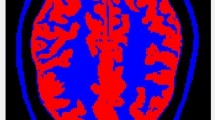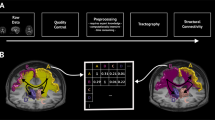Abstract
A new approach for quantifying the degree of connectivity between human brain regions from Diffusion Tensor Magnetic Resonance Imaging (DT-MRI) data is presented. To this aim, a functional is proposed and its theoretical properties are shown. The connectivity between pairs of white matter points is quantified by minimizing the weighted length of the curves within white matter connecting the points to each other. The weighting factor is a decreasing function of the diffusion coefficient along the curve tangent. This coefficient is a linear function of the diffusion tensor components, which are estimated from DT-MRI data. As a by-product of the analysis, the minimizing curves connecting the two points are provided. The solution of the minimization problem is obtained numerically by approximating the functional on a lattice and then solving a shortest path problem on an undirected weighted graph. The presented method is global and therefore not affected by problems due to fiber branching and crossing. It is also automatic and fast. Some results obtained from the implementation of this method on real data in physiological and simulated pathological conditions are illustrated.
Similar content being viewed by others
References
P.J. Basser, J. Mattiello, and D. LeBihan, “Diffusion tensor spectroscopy and imaging,” Biophysical Journal, Vol. 66, pp. 259–267, 1994.
D. LeBihan, J. Mangin, J. Poupon, C. Clark, S. Pappata, N. Molko, and H. Chabrat, “Diffusion tensor imaging: Concepts and applications,” Journal of Magnetic Resonance Imaging, Vol. 13, No. 4, pp. 534–546, 2001.
U. Wieshmann, C. Clark, M. Symms, F. Franconi, G. Barker, and M. Osteaux, “A method for myelin fiber orientation mapping using diffusion–weighted MR images,” Magnetic Resonance Imaging, Vol. 12, No. 3, pp. 443–454, 1994.
M. Filippi, M. Cercignani, M. Inglese, M. Horsfield, and G. Comi, “Diffusion tensor magnetic resonance imaging in multiple sclerosis,” Neurology, Vol. 56, No. 3, pp. 304–311, 2001.
M. Bozzali, A. Falini, M. Franceschi, M. Cercignani, M. Zuffi, G. Scotti, G. Comi, and M. Filippi, “White matter damage in Alzheimer’s desease assessed in vivo using diffusion tensor magnetic resonance imaging,” Journal of Neurology, Neurosurgery & Psychiatry, Vol. 76, pp. 742–746,2002.
B. Matthews, Multiple Sclerosis: The Facts, Oxford University Press: New York, 1993.
U. C. Wieshmann, C. Clark, M. Symms, F. Franconi, G. Barker, and S. Shorvon, “Reduced anisotropy of water diffusion in strucutral celebral abnormalities demonstrated with diffusion tensor imaging,” Magnetic Resonance Imaging, Vol. 17, No. 9, pp. 1269–1274, 1999.
E.W. Hsu and S. Mori, “Analytical expressions for the NMR apparent diffusion coefficients in an anisotropic system and a simplified method for determining fiber orientation,” Magnetic Resonance in Medicine, Vol. 34, No. 3, pp. 194–200, 1995.
C. Tench, P. Morgan, M. Wilson, and L. Blumhardt, “White matter tracking using diffusion tensor MRI,” Magnetic Resonance in Medicine, Vol. 47, No. 5, pp. 967–972, 2002.
P. Basser, S. Pajevic, C. Pierpaoli, J. Duda, and A. Aldroubi, “In vivo fiber tractography using DTI–MRI data,” Magnetic Resonance in Medicine, Vol. 44, No. 4, pp. 625–632, 2000.
M.M. Fernandez, C.A. Lopez, J.R. Alzola, and C.F. Westin, “Regularization of diffusion tensor maps using a non–gaussian Markov random field approach,” in Proceedings of Medical Imaging, Computing and Computer Assisted Intervention, R.E. Ellis and T.M. Peters (Eds.), Lecture Notes in Computer Science, Springer Verlag (Berlin Heidelberg), Vol. 2879, pp. 92–100, 2003.
J.S. W. Campbell, K. Siddiqi, B.C. Vemuri, and G.B. Pike, “A geometric flow for white matter fiber tract reconstruction,” IEEE Symposium on Biomedical Imaging, pp. 505–508, 2002.
M. Bjornemo, A. Brun, R. Kikinis, and C.F. Westin, “Regularized stochastic white matter tractography using diffusion tensor MRI,” in Proceedings of Medical Imaging, Computing and Computer Assisted Intervention, T. Dohi and R. Kikinis (Eds.), Lecture Notes in Computer Science, Springer Verlag (Berlin Heidelberg), Vol. 2488, pp. 435–442, 2002.
C. Poupon, C.A. Clark, V. Frouin, J. Regis, I. Bloch, D. Le Bihan, and J.F. Mangin, “Regularization of diffusion, based direction maps for the tracking of brain white matter fascicles,” NeuroImage, Vol. 12, pp. 184–195, 2000.
G.J.M. Parker, H.A. Haroon, and C.A.M. Wheeler-Kingshott, “A framework for a streamline-based probabilistic index of connectivity (PIco) using a structural interpretation of MRI diffusion measurements,” Journal of Magnetic Resonance Imaging, Vol. 18, pp. 242–254, 2003.
C. Lenglet, R. Deriche, and O. Faugeras, “Inferring white matter geometry from diffusion tensor MRI: application to connectivity mapping,” in Proc. of 8–th Eur. Conf. Comp. Vision, Prague, Czech Republic, pp. 127–140, 2004.
G.J.M. Parker and D.C. Alexander, “Probabilistic Monte Carlo based mapping of cerebral connections utilising whole brain crossing fibre information,” in Proc. Information Processing in Medical Imaging, Ambleside, UK, pp. 684–695, 2003.
P. Hagmann, J.P. Thiran, L. Jonasson, P. Vandergheynst, S. Clarke, P. Maeder, and R. Meuli, “DTI mapping of human brain connectivity: Statistical fiber tracking and virtual dissection,” NeuroImage, Vol. 19, pp. 545–554, 2003.
P. Lancaster and M. Tismenesky, The Theory of Matrices: Second Edition with Applications, Springer: New York, 1978.
V.I. Arnold, Mathematical Methods of Classical Mechanics, Computer Science and Applied Mathematics, Academic Press, Inc: San Diego, CA, 1985.
L.R. Frank, “Characterization of anisotropy in high angular diffusion-weighted MRI,” Magnetic Resonance in Medicine, Vol. 47, pp. 1083–1099, 2002.
D.S. Tuch, T.G. Reese, M.R. Wiegell, N. Makris, J.W. Belliveau, and V.J. Wedeen, “High angular resolution diffusion imaging reveals intravoxel white matter fiber heterogeneity,” Magnetic Resonance in Medicine, Vol. 48, pp. 577 – 582, 2002.
K.J. Friston, A.P. Holmes, K.J. Morsley, J.B. Poline, C. D. Frith, and R.S.J. Frackowiak, “Statistical Parametric Maps in functional imaging: A general linear approach,” Human Brain Mapping, Vol.2, pp. 189–210, 1995.
P. Soille, Morphological Image Analysis, Springer–Verlag: Berlin, Germany, 1999.
J. Sijbers, A.J. den Dekker, E. Raman, and D. Van Dyck, “Parameter estimation from magnitude MR images,” International Journal of Imaging Systems and Technology, Vol. 10, pp. 109–114, 1999.
S. Pajevic and P.J. Basser, “Parametric and non-parametric statistical analysis of DT-MRI data,” Journal of Magnetic Resonance, Vol. 161, pp. 1–14, 2003.
C.F. Westin, S.E. Maier, H. Mamata, A. Nabavi, F.A. Jolesz, and R. Kikinis, “Processing and visualization for diffusion tensor MRI,” Medical Image Analysis, Vol. 6, pp. 93–108,2002.
D. Tschumperlè, and R. Deriche, “Variational frameworks for DT-MRI estimation, regularization and visualization,” in Proc. of International Conference in Computer Vision, Nice, France, Vol. 1, pp. 116–121, 2003.
Z. Wang, B.C. Vemuri, Y Chen, and T.H. Mareci, “A constrained variational principle for direct estimation and smoothing of the diffusion tensor field from complex DWI,” IEEE Transactions on Medical Imaging, Vol. 23, No. 8, pp. 930–939, 2004.
T.F. Coleman and Y. Li, “An Interior, Trust Region Approach for Nonlinear Minimization Subject to Bounds,” SIAM Journal on Optimization, Vol. 6, pp. 418–445, 1996.
B. Simeone, P. Toth, G. Gallo, F. Maffioli, and S. Pallottino (Eds.), “Fortran Codes for Network Optimization,” Annals of Operations Research, Vol. 13, J. C. Balzer, Basel,1988.
J. Zhang, H.J.N. Kang, and N. Cao, “Fiber tractography in diffusion tensor Magnetic Resonance Imaging: A survey and beyond”, Technical report 437/05, Department of Computer Science, University of Kentucky, 2005.
Author information
Authors and Affiliations
Corresponding author
Additional information
Giovanni Sebastiani is currently senior researcher at Istituto per le Applicazioni del Calcolo “M. Picone”, CNR, Rome, Italy. In 1998, he received the title of Doctor Philosophiae in Mathematics from the University of Science and Technology, Trondheim, Norway. His scientific interests mainly belong to Probability, Statistics and Physics applied to Medicine and Biology. His web page is at http://www.iac.rm.cnr.it/∼sebast/
Francesco de Pasquale received his Ph.D. in Applied Statistics from the University of Plymouth, United Kingdom in 2004 discussing a thesis on Bayesian and Template based methods for image analysis. Since his degree in Physics obtained at the University of Rome, “La Sapienza” in 1999 his work has been focused on developing models and methods for Magnetic Resonance Imaging, in particular image restoration, classification and segmentation in a Bayesian framework. After being appointed a two-year position as a Lecturer at the University of Plymouth from 2003–2004 he is now a post-doc researcher at IAC, an Institute of the Italian National Research Council, Rome, Italy. He is currently involved with Prof. Gian Luca Romani in a project on Functional MRI with the University of Chieti.
Piero Barone was born in Rome, Italy, in 1949. He received the “laurea” degree in mathematics from the University of Rome “La Sapienza” in 1972. He joined the Istituto per le Applicazioni del Calcolo (IAC) of the italian National Research Council in 1975. In 1992 he was appointed research director at IAC where leads a group of biomedical image and signal processing. His current research interests are in stochastic Pade’ and Bayesian methods applied to spectral analysis and in fast image regularization and classification. Magnetic Resonance spectroscopy, relaxometry, dosimetry and dynamic and diffusion tensor MRI are typical application fields. In the past he worked on space-time processes related to electrocardiac studies (body surface potential mapping), on deconvolution problems, stochastic algorithms and orthogonal transforms. Dr. Barone coauthored more than ninety papers on international journals and an european patent. He served as a project referee for the National Science Foundation and the Norvegian Research Council.
Rights and permissions
About this article
Cite this article
Sebastiani, G., de Pasquale, F. & Barone, P. Quantifying Human Brain Connectivity from Diffusion Tensor MRI. J Math Imaging Vis 25, 227–244 (2006). https://doi.org/10.1007/s10851-006-6896-0
Published:
Issue Date:
DOI: https://doi.org/10.1007/s10851-006-6896-0




